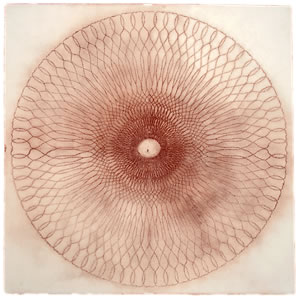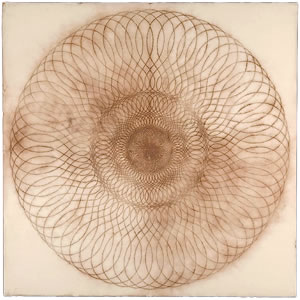
| return to top |
| return to top |
| return to top |
 |
MARY JUDGE
A thoroughly contemporary artist Judge has, with subtlety and skill, revived an ancient technique and made it completely her own. Developed in the Renaissance, Spolvero, literally "dusting" in Italian, was the means whereby large designs for fresco could be transferred to the walls. In this technique dry earthen pigments are dusted or "pounced" through tiny holes that have been punched along the lines of a drawing. When the paper template is removed the drawing appears transformed, softened by the cloud of dry pigment, yet clearly rendered. In her large and varied body of work utilizing this technique Mary Judge has wedded its' gentle imprecision to a crisp aesthetic based on a linear and modular approach to form. Developing her ideas on folded sheets of paper, the finished works often express a bilateral symmetry which strongly suggests the body, an association somehow made stronger by her choice of raw earth pigments in warm shades. Her concentric lines suggest other associations as well, such as the rings in the cross section of trees, baroque typography, or arabic calligraphy and their graceful repetition of form evokes a meditative response in the viewer. In a 2001 interview she stated, "My images are figurative, that is, they have an objectness, that pure abstract forms don't have. They express a state of being rather than pure non objectivity." |
||||||||||||||||
Exotic Hex Series  Exotic Hex Series |
|||||||||||||||||
| |||||||||||||||||
HOME . ABOUT US . ARTISTS . CURRENT EXHIBITION . UPCOMING EXHIBITION
ARCHIVE . DIRECTIONS-MAP . CONTACT . SUBMISSIONS




